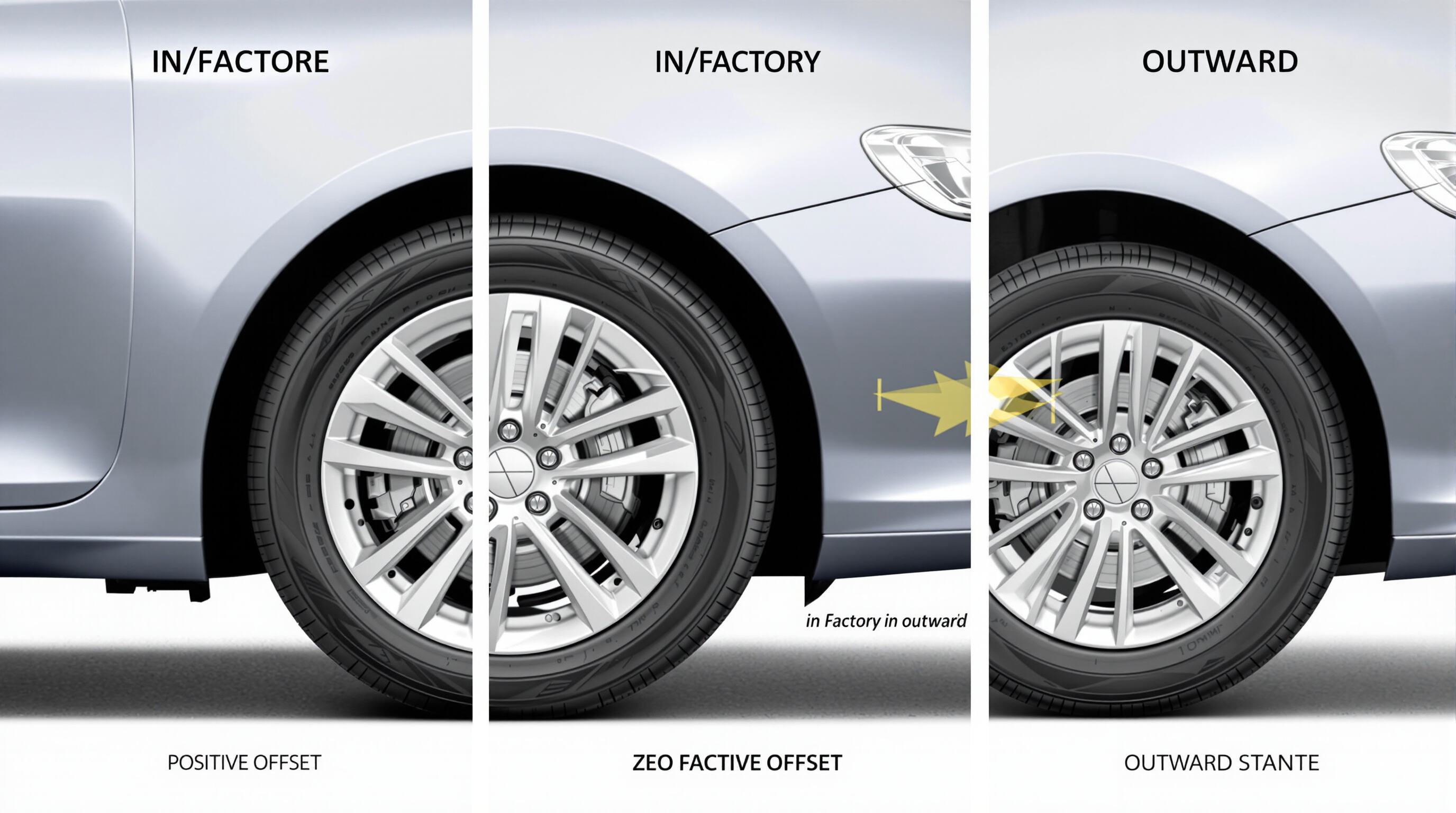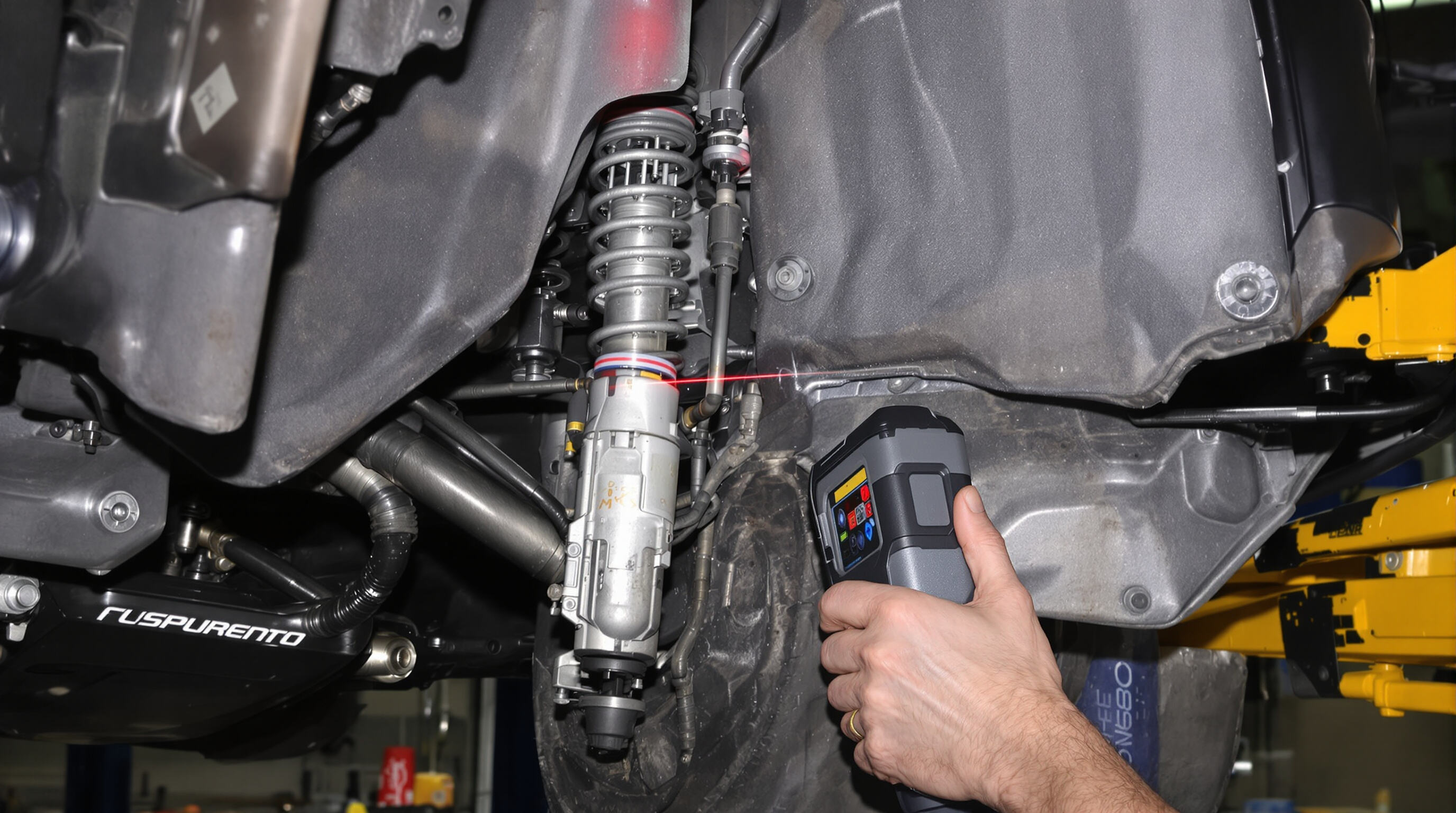
የውheelsል ቅርፅ በመሠረቱ የውheelsል የማጠናከሪያ ገጽ ከዚህ የመሃል መስመር ርቀት በሚሆነበት ጊዜ በሚሊሜትር ይገለጻል። በአሁኑ ጊዜ ለመኪናዎች ሲመለከቱ ይህ ቁጥር የውheelsል በፊት አካል ወይ በፊት የፍየንዳር ውስጥ ወይም በጓድ ጎን በትክክል ለመቆም ይወስናል። ለአብዛኛው አዲስ ምርቶች በመሸከም ጊዜ የሚሰጡት ቅርፅ በተለይ በ+30mm እና +60mm መካከል ይደርሳሉ ምክንያቱም ይህ ማሽከርከር ጥገቶችን በቀላሉ ለማድረግ እና ትክክለኛ የophanging ጫማ ለማስቆም ይረዳል። አንዳንድ ሰዎች ደግሞ የተለያዩ ቅርፅ መለኪያዎች ጋር የተቀየሩ ወheelsሎችን ይወዱታሉ። ይህ የተሻሻሉ ወheelsሎች የሚያስችሉት የተጫወቁ ሰዎች በራሳቸው እንቅስቃሴ ወይም በቀለሙ ላይ የሚታዩትን በተሻለ መንገድ ለማስተካከል ነው። የኤድመንድስ የውheelsል የመገጣጠሚያ ዋና መመሪያ የዘር ወይም የተለያዩ የውheelsል አማራጮች ላይ ዝርዝር መረጃ ይሰጣል የመኪናውን የውጭ መታየት እና የመንቀሳቀስ ግንባታ ለማሻሻል የሚፈልጉትን ለማሳካት።
| የቅርፅ አይነት | የማስተማር ተጽእኖ | የሰንሰለት ግዜኦሜትሪ ተጽዕኖ |
|---|---|---|
| አዎንታዊ | የመዞሪያውን ሳጥን ወደ ውስጥ ያስገባል | የማሽከርከር አገዳሚውን ለማስገቢያ ስሜት ያቀንሳል |
| አሉታዊ | የመዞሪያውን ሳጥን ወደ ዉጭ ያግናል | የፒስተን ስፋት ይሰፋል፣ የማቆሚያ ኃይልን ይጨምራል |
| ዜሮ | የመዞሪያውን ሳጥን በፌንደር መሃል ይደርሳል | የፋብሪካው የሰንሰለት አንግል ይጠብቃል |
የፊት ሞተር የሚጎዱት መኪናዎች በጂሩ መጨረሻ ላይ የሚንሸራተቱትን ማፋጠን ለመጨመር በተለይ የሚያገለግሉት የአዎንታዊ ኦፍሴቶች ጥቅም ነው። ከዚያም በተለየ መጠን የተስተካከለ ከሆነ የውheelsል ማሽከርከር ጊዜ ሊያፋጥን ይችላል ግን የአሉታዊ ኦፍሴቶች በባህር ውጭ እና በማዕረግ ማሰሪያዎች ውስጥ ተወዳዳሪ ናቸው (ፔነሞን 2023)።
የውheelsል ኦፍሴት መቀየር ሶስቱን ዋና የማስገቢያ ሂደቶች በቀጥታ ይነካል፡፡
እ даже 5mm ለውጥ በስክሮብ ራዲየስ ውስጥ እስከ 15% ለውጥ ሊፈጥር ይችላል፣ የደህንነቱን ተቆጣጣሪነት ለመጠበቅ ትክክለኛ የሰውነት ጥምር ይፈልጋል። እንደዚህ ዓይነት ለውጦች የመንገድ አገልግሎት ዋስትና ጥቅም ላይ ሊዋስኑ ይችላሉ፣ ስለዚህ የተገቢ አቀናባት አስፈላጊ ነው።
አንድ ሰው የተቀየረ በር ጎማዎችን ከመሰጡ በኋላ እንደሚለው በእነዚህ ጎማዎች ላይ የሚገኝ የታሬ ጎማ እንዴት እንደሚጎተት እና የመኪናው የማስተላለፊያ ሥርዓት ጋር የሚያገናኝበት ነጥብ ይለወጣል፣ ይህም በመዞሩ ወቅት የመኪናው አፈፃፀም ላይ ትልቅ ተጽዕኖ ይኖረዋል። የወደፊት በር ያላቸው ጎማዎች በአጠቃላይ የመዞርን ሂደት ቀላል ያደርጋሉ እና በከፍተኛ ፍጥነቶች ገጽታ ያሳያሉ። ከዚህ በተቃራኒው፣ አሉታዊ በር ያላቸው ጎማዎች የመኪናውን ምላሽ በመዞር ወቅት ፈጣን ያደርጋሉ፣ ይህም የፓሪ መኪናዎች ለመንገድ ቀዳዳዎች ወይም ለአውቶክሮስ ማዕከሎች የሚወዱት ነው። ግን እዚህ ላይ ሰዎች ጠበቅ መሆን ያስፈልጋል። በፋብሪካውያን የተወሰኑ መጠኖች በግምት 15 ሚሜ በላይ የሚያንፀባርቅ ማንኛውም ለውጥ ችግሮችን ሊፈጥር ይችላል፣ በተለይ ግን መንገዶቹ የተበበሩ ወይም የተጎዳና ከሆኑ። የኤድመንድስ የበር በር የደህንነት መመሪያ እዚህ ላይ የተጠቀሰውን ተመሳሳይ ችግር ስለሚወስን ለውጦቹን መፈተሽ በጣም አስፈላጊ ነው።
ኦፍሴት አስተካክሎች ዋና የሰንሰለት መለኪያዎች እና የታሬ ጥብቅ ጉዳይ ይነካል፡
| ኦፍሴት አስተካክል | ስክሮብ ራዲየስ ተጽዕኖ | የታሬ ግንኙነት ውጤት |
|---|---|---|
| +10mm | 8-12% ይቀንሳል | በመሃል ክፍል ላይ የተመተዘ |
| -10mm | 15-20% ይጨምራል | በፋራ መጻፍ |
እነዚህ ለውጦች በመቆራረጥ ጊዜ እና በማዕዘን ጊዜ የሚዛወሩትን ክብደት ይነካዋል። ከአሉታዊ ቅርፅ ጣዕም ጋር በተጨማሪ የሚታየው ስክራብ ራዲየስ በደረቅ ግራይፕ ላይ ማሻሻያ ሊኖረው ይችላል ግን በፊት ማሽከርከር የሚያሳየውን በርበር በመጨመር ሊያሳሽ ይችላል።
በ2023 ዓ.ም. የመንገድ ትንታኔ ተመሳሳይ የስፖርት መኪናዎችን በተለያዩ ቅርፅ በመጠቀም በ265/35R19 መከላከያዎች ጋር አወዳድረች፡
ይህ ቅርፅ መምረጫ የመንገድ ሁኔታዎች እና የመፈናቀል ግቦችን ማስተማማን እንዴት እንደሚገባ ያሳያል።
አብዛኛው የመኪና አምራቾች የፎርማ ስፔሲፋኬሽኖች ከ7 ሚሜ በላይ ማራቅ እንዳይሆን ይመክሩታል እንዲህ ማድረግ በጣም የተጠቃሚ መኪናው በተሻለ መንገድ ማስተናገድ እና በጣም ረጅም ጊዜ ያህል ችግር የሌለው መሆን ይረዳል፡፡ የመኪና ጓደኛዎች ግን በተለይ የሚመለከታቸው የፎርማ መጠኖችን በከፍተኛ መጠን ማሳደግ ነው አንዳንድ ጊዜ የፎርማ መጠኖችን በ10 እስከ 15 ሚሜ ድረስ ማሻያ ይፈልጋሉ፡፡ ይህ ማለት የፎርማ ቦታዎች (bushings) በተለያዩ ጊዜ የሚቆዩ ሊሆኑ ይችላሉ እስከ 8 እስከ 12 በመቶ የሚጠጋ ጊዜ የሚቆዩ ሊሆኑ ይችላሉ ግን በተሻለ መንገድ መዞር ይችላሉ፡፡ ለእነዚህ የተለያዩ የኤድያፕቲቭ ስፑስፓንሽን ያላቸው መኪናዎች የፎርማ መጠን በከፍተኛ መጠን በ5 ሚሜ በላይ ሲሆን የኤሌክትሮኒክ ስታቢሊቲ ኮንትሮሎች በተሻለ መንገድ ለመስራት አንድ አይነት ሪካሊብሬሽን ስራ ይፈልጋል፡፡ ይልቁ እነዚህን አይነት ስራዎች ካድረጉ በኋላ በተለያዩ ጊዜዎች የማይታወቅ መንገድ ላይ መኪናውን ማስተናገድ ይችላሉ፡፡

የትክክለኛ ቦታ መገናኛ ማለት የሚያስፈልገውን ቦታ በተሻለ መፈተሽ ነው። ለተሻሻሉ ብስክሌቶች ያለ ማሻሻያ በሙሉ የማስፋፋት ሲሆን በጎማው እና በፌንደሩ መካከል ለምንጭ ሲታገብ 3 እስከ 5 ሚሊሜትር ቦታ መኖር አለበት። ወይድ ኮርፖሬሽን ከመደበኛው የሚበልጥ ቦታ ይሰጣል ስለዚህ በመካከለኛው የመንገድ ስፋት በስሜ ማርክ 2023 የአፍተርማርኬት ማሽን ጥናት መረጃ እንደሚታየው ከ15 ሚሊሜትር በላይ የስፋት አቅራቢያ ይፈቅዳል። በመኪናው ላይ ምንም ነገር ስናስቀምጥ በጣም በፊት በተለያዩ አካላት መካከል የመሳሪያዎች ችግር ሊኖርባቸው የሚችል ቦታ ለመፈተሽ በብዙ ቦታዎች የሚገነቡ በሆኑ ቅይጥ ሞዴሎች ወይም በላዘር ይጠቀማሉ። እነዚህ ዘዴዎች ችግሮቹን በቅድሚያ ማግኘት በማድረግ ጊዜ እና ገንዘብ ይቆጥባሉ።
የተለመደው የማስተካከያ ጥሪዎች ይህን ያካትታሉ፡
+2-3 ሚሊሜትር በእያንዳንዱ የማስተካከያ ጊዜ መጨመር እና የበለጠ የመሳሪያ ጣራ ማጣራት በመጠቀም የተለያዩ አደጋዎችን መቀነስ።
ባለሙያዎች አነስተኛውን ማቆያ ማቆየት ይመከራሉ 5mm ቦታ ክፍተት የጎማዎች እና የተጠቀመባቸው አካላት መካከል፡ ይህ ቦታ ማስተዋወቂያ ስህተቶችን እና የካርሻስ ማወኛን ይደግፋል፡ በረጅም ጊዜ የጎማ ባዮች እና የመቆጣጠሪያ ባዶዎች ላይ የሚያሳድር ጭንቅላትን እስከ 40%በድurableታ ፈተናዎች ውስጥ፡
የጎማውን ማዛወር ማሻሻል የመኪና ባለቤቶች ጎማዎቻቸውን በትክክል በእነዚያ የወንጭፍ ጉድጓዶች ውስጥ እንዲያስቀምጡ ያስችላቸዋል ፣ የተሽከርካሪውን ትክክለኛ አሠራር ሳይረብሹ እነዚያን የሚያበሳጩ ክፍተቶች ያስወግዳሉ። ከ2024 የኦቶሞቲቭ ስታይሊንግ ጥናት የተገኘው መረጃ እንደሚያሳየው ከ4 የመኪና አድናቂዎች መካከል 3ቱ ጎማው በትክክል ከሰውነት ጋር የሚጣጣምበትንና እንዲቀመጥ የታሰበበትን መልክ ማግኘት ይፈልጋሉ። ስለ አሉታዊ ማዛመዶች ስንናገር እነዚህ ተሽከርካሪዎች ሰዎች በጣም የሚወዱትን ደፋር የሩጫ መኪና ስሜት ይሰጣሉ። አዎንታዊ ቅነሳዎች ግን ነገሮችን ከፋብሪካው በቀጥታ ከሚመጣው ጋር የሚመሳሰሉ ንጹሕና የተደራጁ እንዲሆኑ ያደርጋሉ። ያም ሆነ ይህ፣ ማንም ሰው እነዚያ ጎማዎች በመኪናው ውስጥ በጣም ጥልቅ ሆነው ማየት አይፈልግም።
የአሁኑ የመሬት አቀማመጥ ትረንዶች የተወሰኑ ኦፍሴት መርጠኛዎችን ያሳያሉ፡
በመጀመሪያ የሚመለከታቸው በርካታ ባህሪዎች በ5mm የሚለውን መደበኛ ለውጥ ደንብ ይከተላሉ—በትንሽና በተወሰነ መንገድ ለውጦች ማድረግ በተገቢው መንገድ ለመቀየር የሚያስችል እንዲሁም ለተጠቃሚው የመተላለፊያ እና የደህንነት ጥራት የማይጎድለው
የመንጫ መጠን የመንጫው የመገጣጫ ገጽ ከመንጫው ወሰን ገዥ የሚገኝበትን ርቀት ያሳያል፣ ይህም በሚሊሜትር ይለካል። ይህ መጠን የመንጫው አቀማመጥ ከፍንድሮው ጋር እንዴት የሚዛመድ ይወስናል።
የመንጫ መጠን የመሽከርከር ምላሽ፣ የመንገድ ማስተማር፣ የማንጫ ግንባታ፣ እና የመቆጣጠሪያ አፈፃፀም ይነካል። የአዎንታዊ መጠኖች በአብዛኛው የመንገድ ማስተማር ይሻሻላሉ፣ ሲሆን የአሉታዊ መጠኖች የመሽከርከር ምላሽ ይሻሻላሉ።
የመወሰኑ መጠን የተመዘገበውን ገደብ በማለፍ የመንጫ መጠን ለውጥ የሚያስከትለው በመጨረሻው የመንገድ ማስተማር ላይ ተጽዕኖ የሚኖርበት፣ የተለየ መቆጣጠር፣ እና ሊከሰት የሚችል የማንጫ አካላት ጋር የመሳሰሉ ችግሮች ሊያስከትል ይችላል።
አዎ፣ የጎማ ቦታ ማንጠልጠያ ለመርከቦች እና ለማስተላለፊያ ዋስትና የሚያስከትለው ችግር ሊፈጥር ይችላል እና የማምረቻው አምራች በወarrantyል ዋስትና ውስጥ የማይገኝ ከሆነ ዋስትናውን ይሰርዛል።
አምራቾቹ በደፈናው የተወሰነው ከፍተኛ መጠን ውስጥ የጎማ ቦታ ማንጠልጠያን ለማቆየት ያነሳሉ ለተሻለ ትብታና ስላሳዊነት ለቀን ቀን መንገድ።